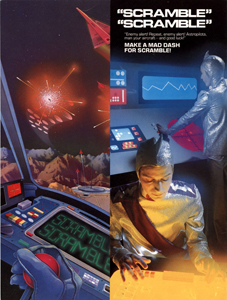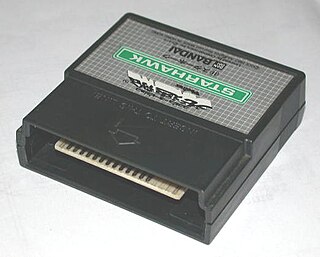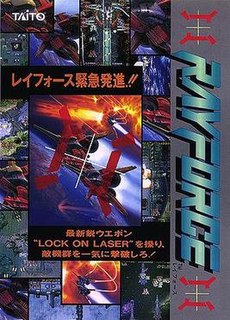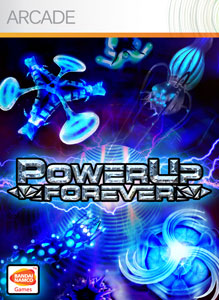
Asteroids is a space-themed multidirectional shooter arcade game designed by Lyle Rains and Ed Logg released in November 1979 by Atari, Inc. The player controls a single spaceship in an asteroid field which is periodically traversed by flying saucers. The object of the game is to shoot and destroy the asteroids and saucers, while not colliding with either, or being hit by the saucers' counter-fire. The game becomes harder as the number of asteroids increases.

Radiant Silvergun is a shoot 'em up developed by Treasure. It was originally released in Japanese arcades in 1998 and subsequently ported to the Sega Saturn later that year. The story follows a team of fighter pilots in the far future who are battling waves of enemies summoned by a mysterious crystal dug up from the Earth. The player hosts an arsenal of six different types of shots to choose from, and a sword to destroy nearby targets. The stages are tightly designed to present players with scenarios that can be approached differently with the various weapon types.

Radar Scope is a 1980 fixed shooter arcade game developed by Nintendo R&D2 and published by Nintendo. The player assumes the role of the Sonic Spaceport starship and must wipe out formations of an enemy race known as the Gamma Raiders before they destroy the player's space station. Gameplay is similar to Space Invaders and Galaxian, but set in a forced perspective angle.

Racing video games are a video game genre in which the player participates in a racing competition. They may be based on anything from real-world racing leagues to fantastical settings. They are distributed along a spectrum between simulations and simplified arcade-style racing games. Go-kart racing games emerged in the 1990s as a popular sub-genre of the latter. Racing games may also fall under the category of sports games.

Scramble is a side-scrolling shooter game released for arcades in 1981. It was developed by Konami, and manufactured and distributed by Leijac in Japan and Stern in North America. It was the first side-scrolling shooter with forced scrolling and multiple distinct levels. It was a commercial success, selling 15,136 arcade cabinets in the United States within five months and becoming Stern's second best-selling game. Its sequel was the more difficult Super Cobra.

Galaxian is a 1979 fixed shooter arcade game developed and published by Namco. It was licensed and distributed by Midway Manufacturing in North America. The player assumes control of the Galaxip starfighter in its mission to protect Earth from waves of aliens. Gameplay involves destroying each formation of aliens, who dive down towards the player in an attempt to hit them.

Gyruss is an arcade shoot 'em up game designed by Yoshiki Okamoto and released by Konami in 1983. Gyruss was initially licensed to Centuri in the United States for dedicated machines, before Konami released their own self-distributed conversion kits for the game. Parker Brothers released contemporary ports for home systems. An enhanced version for the Family Computer Disk System was released in 1988, which was released to the North American Nintendo Entertainment System in early 1989.

Salamander, retitled Life Force in North America and in the Japanese arcade re-release, is a scrolling shooter arcade game by Konami. Released in 1986 as a spin-off of Gradius, Salamander introduced a simplified power-up system, two-player cooperative gameplay and both horizontally and vertically scrolling stages. Some of these later became the norm for future Gradius games.

Starhawk is a 1979 vector arcade game designed and programmed by Tim Skelly and manufactured by Cinematronics. Starhawk is a shoot 'em up unofficially based on the Star Wars: Episode IV trench run, the first arcade game to blatantly use concepts from Star Wars. The game was unique at the time for its pseudo-3D graphics. It was released for the Vectrex home system in 1982.

Space Rogue is a space flight simulation video game developed by Origin Systems and published by Origin Systems, Wave Brain, and Night Dive Studios. The game was released in 1989 for Apple II, and Commodore 64, for MS-DOS, the series was ported to MS-DOS, Macintosh, Amiga, and Atari ST. The game was also released in the Japanese language for PC-9801, X68000, and FM Towns. The FM Towns version had its intro remade with slight animations and new illustrations, along with scrolling Japanese text, and exclusive CD quality background music. Taking place within the Far Arm of the Milky Way galaxy, Space Rogue's main story revolves around the player character's efforts to pursue a career and undertake long-range goals beyond his immediate mission.

Konami Collector's Series: Arcade Advanced, known in Europe as Konami Collector's Series: Arcade Classics, is a compilation video game created by Konami. It was first released on March 22, 2002 for the Game Boy Advance. A version was also released as a plug & play by Majesco Entertainment.
Gradius is a series of shooter video games, introduced in 1985, developed and published by Konami for a variety of portable, console and arcade platforms. In many games in the series, the player controls a ship known as the Vic Viper.

RayForce is a vertically scrolling shooter by Taito for the Taito F3 arcade hardware and released in 1994. It was ported to the Sega Saturn in 1995, Microsoft Windows in 1997, then rereleased for iOS in 2012 and Android in 2017.

Star Trek: Strategic Operations Simulator is a space combat simulation arcade game based on the original Star Trek television program and movie series, and released by Sega in 1983. Star Trek uses color vector graphics for both a 2D display and a 3D first-person perspective. The player controls the Starship Enterprise and must defend sectors from invading Klingon ships. The game includes synthesized speech

Astro Fantasia is a fixed shooter arcade game released by Data East in 1981.

TwinBee is a vertical-scrolling shoot 'em up game originally released by Konami as an arcade game in 1985 in Japan. Along with Sega's Fantasy Zone, released a year later, TwinBee is credited as an early archetype of the "cute 'em up" type in its genre. It was the first game to run on Konami's Bubble System hardware. TwinBee was ported to the Family Computer and MSX in 1986 and has been included in numerous compilations released in later years. The original arcade game was released outside Japan for the first time in the Nintendo DS compilation Konami Classics Series: Arcade Hits. A mobile phone version was released for i-mode Japan phones in 2003 with edited graphics.

Thunder Cross (サンダークロス) is a horizontally scrolling shoot 'em up arcade game released by Konami in 1988. It used a "layered scrolling" background, a new 2D graphics technique at the time. The game spawned a sequel, Thunder Cross II, in 1991. Owing to several similarities, Space Manbow (1989) may also be considered a spin-off.

PowerUp Forever is a downloadable multi-directional shooter developed by Blitz Arcade and published by Namco Bandai for the Xbox 360 via Xbox Live Arcade and the PlayStation 3 via PlayStation Network. It was released on Xbox Live Arcade on December 10, 2008 and the PlayStation Network on December 11, 2008. The title is a reference to the game Warning Forever, which was one of the influences for the game

Exerion is a video game developed and published by Jaleco. It was released in arcades on February 1983 and licensed to Taito for manufacture and distribution of the game in North America. The player controls a starship and must fire at enemies on the screen while avoiding projectiles. The game uses a pseudo-3D scrolling background, giving a sense of depth, and the player's ship has a sense of inertia while it is being controlled with the joystick.
Starship 1 is a first-person shooter arcade game developed, manufactured, and released by Atari, Inc. in 1977. The game, which takes great inspiration from the then very popular television series Star Trek, contains the first known Easter egg in any arcade game. Starship 1 was later ported to the Atari 2600 as Star Ship.


















